Affiliate disclosure: This post may contain affiliate links. Please see our Privacy Policy.
For many gardeners, the growing season starts after the last frost in the spring and ends with the first frost of fall. For those of us in cold climates with short frost-free growing seasons, adding cold hardy vegetables to the garden can nearly double the growing season.
There are a number of vegetables that can grow in the fall well past first snow, and even a few vegetables that can grow in winter even in cold climates.
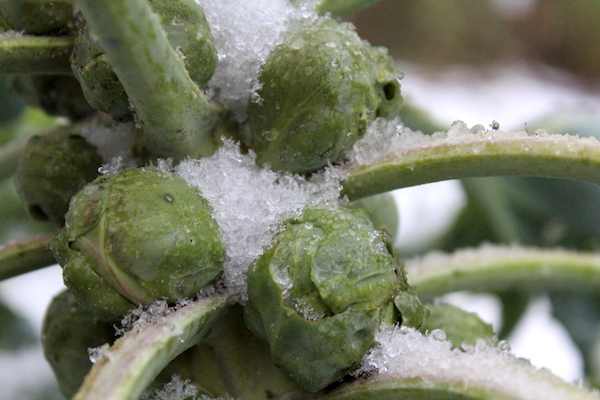
In central Vermont (zone 4), our frost-free growing season is only about 100 days long. During that narrow window, we bring in the heat-loving crops like tomatoes, bush green beans and peppers.
That leaves 265 more days in the year for growing frost-tolerant vegetables. Some vegetables, herbs and fruits will tolerate light frosts and continue growing until a hard-killing frost comes along. Other plants will overwinter under the snow without damage, and enjoy brief periods of growth during mid-winter thaws.
Brussel Sprouts
One of the very hardiest vegetables, Brussel sprouts thrive in our garden for up to 6 weeks after the first frost. Snow really doesn’t seem to bother them, and their waxy leaves will keep growing once it melts off on sunny days.
Once it really gets too cold outside, dig up the whole plant and bring it indoors in a bucket. Strip off the leaves and bring the brussel sprout plant to a cool dark room or basement. Bringing the plant indoors once daytime temperatures are well below freezing will extend the brussel sprout harvest into January even in cold northern climates.
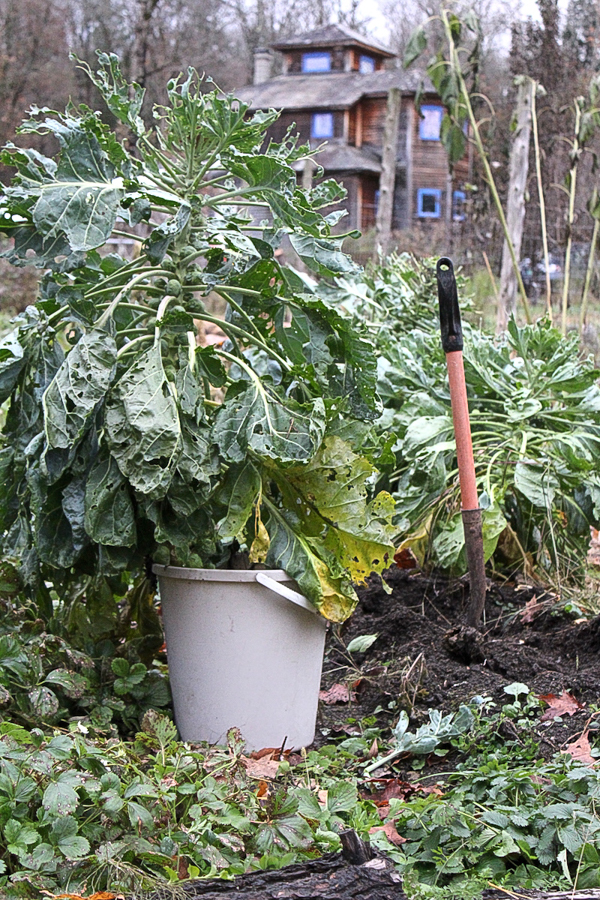
Broccoli and Cauliflower
Both cold weather crops that just don’t grow well in the summer heat. In hot areas like California, these can only really be grown through the cool winter months. Even up here in the north, they’re often planted later in the spring or early summer so that the weather will be cool in the fall when they form heads.
Too much heat and hot weather and they’ll skip forming a head altogether and go directly to seed. Both broccoli and cauliflower can keep growing well into the fall, even when their developing heads are covered in snow.
Cabbage, Kale & Collards
Closely related to Brussel sprouts and broccoli, other vegetables in the Brassicaceae family share the same cold hardiness. There’s a reason that cabbage is a staple vegetable in Russian and Eastern European cooking. They’ll hold in the field long after first snows, and then tightly packed heads will keep in a root cellar until the first vegetables of spring.
Kale and collars are similarly hardy in the field, though they don’t store quite as well when they’re harvested.
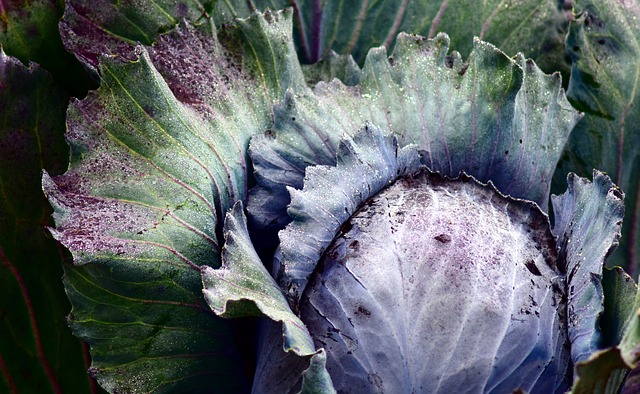
Beets, Carrots & Parsnips
Root crops are evolved to withstand cold, and in fact, they have to overwinter if they’re going to set seed. Beets, carrots and parsnips are biennials, which means they take 2 years to mature and seed. The first year is spent growing a large root to store nutrients over the winter, and fuel fast growth in the spring.
Since the roots of biennial crops need to begin growing again in the spring to produce seed, they must remain viable all winter long. The first fall frosts actually sweeten them, so it’s best to wait as long as possible to harvest them. Root crops are one of the most dependable winter crops, and they can be stored out in the field all winter.
Turnip & Rutabaga
Though these old-time vegetables aren’t grown in most modern gardens, they’re surprisingly tasty. My daughter prefers rutabaga oven fries to potato fries, and that’s saying something for a potato-loving 3 years old.
Consider adding these to your garden if you’re at all excited about winter crops. Both can be harvested well after the last frost and will store until the spring in a root cellar or refrigerator.
Potatoes
Potatoes are a tuber, rather than a true root crop, but growing underground helps protect them from frosts. Potato plants evolved at high altitudes in Peru, where they needed to withstand occasional frosts and still bring in a crop to feed the people.
Planting potatoes about 4 weeks before the last frost in the spring ensures an early crop of new potatoes as little as 8 weeks later. Succession crops planted every few weeks will keep you in a steady supply of potatoes well into the fall.
Other varieties of large storage potatoes are harvested late in the fall, well after first frosts. We’ll wait until the frosts kill the plants to get every last bit of growth into the potatoes below, and then harvest, cure and store our winter crop.
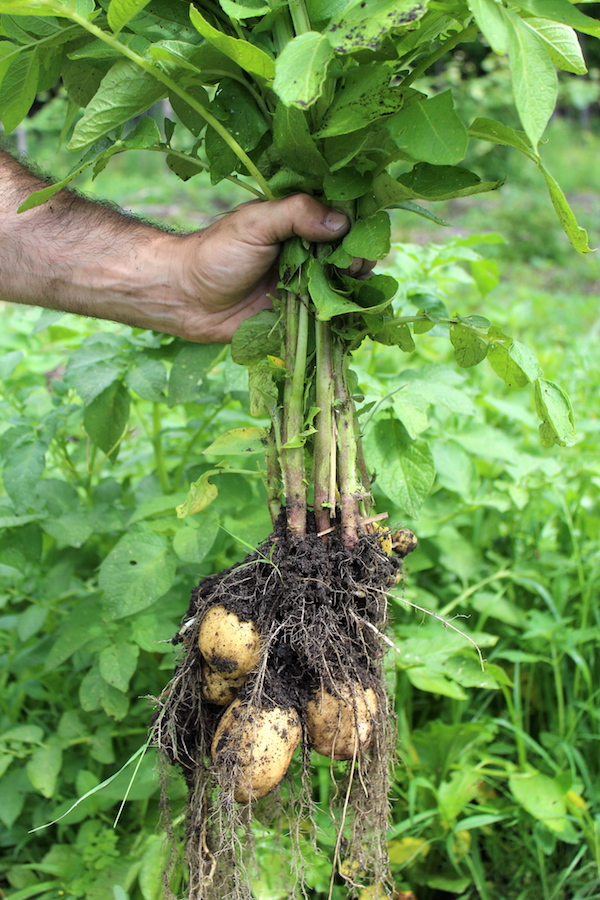
Radishes
While radishes are a root crop just like beets and carrots, they grow a bit differently. Many varieties grow extremely quickly and can be ready for harvest in just a few weeks. Left in the soil too long they become bitter and woody, and it’s not a good idea to store radishes in the ground over winter if you intend to eat them.
They do grow in cold weather though and planting them very early in the spring before the last frost will give you an early vegetable. Alternately, planting them very late in the fall will give you a winter crop after the tender summer vegetables are long past.
Winter Salad Greens
There are way too many winter salad greens to list individually. Many crops, like arugula, only really grow well in cold weather. We planted a large mix of winter salad greens in our attached greenhouse and enjoyed fresh salads in February.
Our greenhouse is unheated, and it gets down to around -15 degrees F in mid-winter. The greens don’t seem to mind, and they just keep on growing, slowing down slightly in the coldest weeks.
Outdoors, winter salad greens can survive in milder areas without protection (zone 5 or 6). A simple row cover in zone 3 or 4 will extend the fresh greens season for several months, allowing for a winter crop of greens without a greenhouse.
Cold hardy winter greens include:
- Spinach
- Arugula
- Mache
- Claytonia
- Tatsoi
- Some types of cold-hardy lettuce varieties including romaine, butterhead and cutting varieties
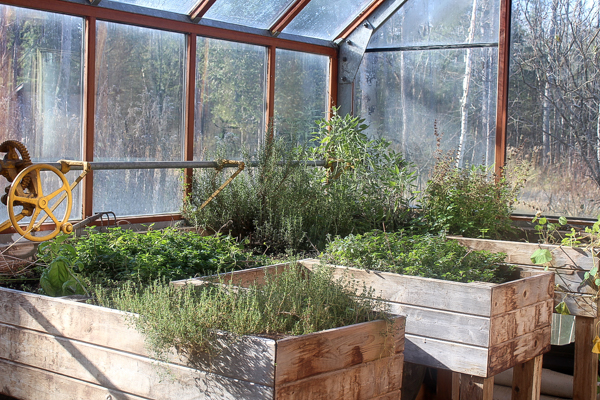
Asian Greens
There are a number of Asian greens that can withstand snow and freezing temperatures to extend the harvest. We love Tatsoi, which is a bit like Bok Choi but more tender and suitable for either salads or cooking.
Bok Choi is also hardy in the snow, as are heads of Asian cabbage.
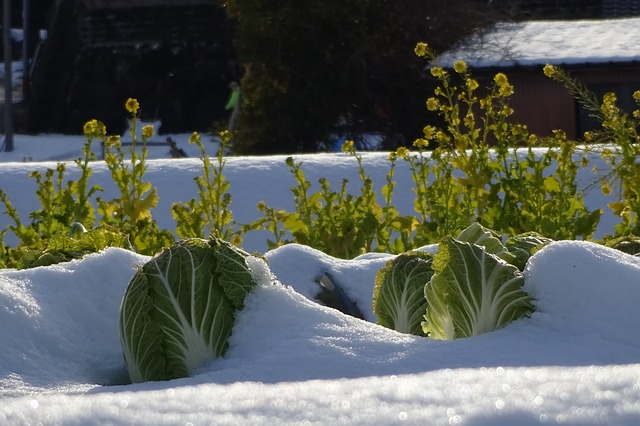
Onions, Leeks and Scallions
Again, you might be noticing a theme with cold-hardy crops and vegetables that grow below ground. The ground is an insulator, and most root crops are planning to grow in the soil for more than a year at a time. Onions aren’t quite a “root crop,” they’re a bulb, but none the less they’re cold-hardy.
Saint David’s Day in Wales falls on March 1st and is celebrated by wearing leeks and eating leek-based foods. Leeks average more than 100 days from planting to maturity and to have leeks on March 1st they’ll need to be cold hardy and survive many frosts in the soil.
In the US, another very early hardy leek crop comes from the wild leeks found throughout the northeast. If you don’t know where to find a wild patch, you can actually just plant wild leeks in your backyard.
Cold Hardy Fruits
We generally think of fall fruits as apples and pears, and it’s true those can withstand light frosts out on the branches without damage. Everbearing strawberries produce strawberries starting in the spring and keep producing through foliage season here in Vermont all the way until Thanksgiving some years. They’ll take an early snow without issue, and then put out new flowers and still ripen another crop of strawberries before going dormant for the winter.
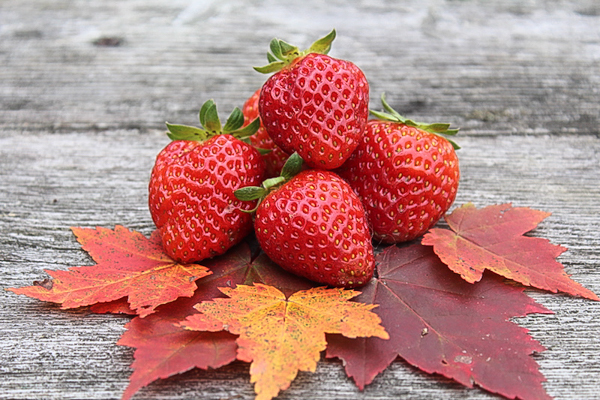
Cold Hardy Herbs
Many herbs don’t seem to mind the cold and will keep on growing right through snow and early frosts. We harvest chives into early December, months after the first frost. They’ll also pop up through the snow in the early spring before the ground has even melted out. Other cold-hardy herbs include:
- Cilantro
- Thyme
- Sage
- Lavender (leaves, not flowers)
Not surprisingly, with the exception of strawberries, the list of cold-hardy vegetables has a heavy overlap with vegetables that grow in shade. That about covers all the winter crops we grow on our homestead, but I’d be interested to know if we missed any of your favorites. I’m always looking for new cold-hardy vegetable varieties.
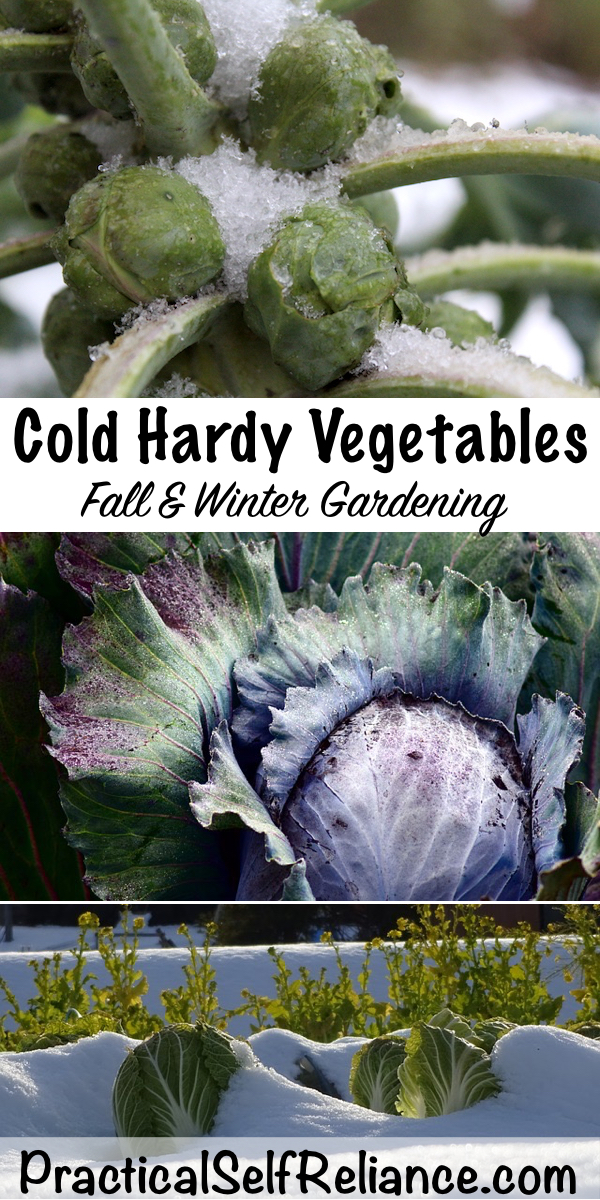














Many great tips here! I’m in zone 5, near the thumb of Michigan, and I planted marshmallow root for the first time, and that, my hot and spicy oregano, fennel, rosemary, and parsley are all trucking right along with my cabbages, arugula, collards and brussels through several frosts and the first snow!
I would love some recipes for cold hardy veggies because my family is pretty picky…my go-to’s are soup with root veggies and greens, and cabbage/collards/brussels fried in a pan with bacon, onions and garlic. They also like coleslaw, but that’s about the end of my repertoire that they will eat.
I love colcannon (mashed potatoes with cabbage in it) but they don’t care for it. Thanks for the info and the tips!
Thank you so much for this article.
Now i can grow stuff in winter as well.
Wonderful!
Love your posts! I have been gardening for years, and enjoy it so much. I plant a large plot of carrots and parsnips every year. In November, the annual raking of the yard happens. Just before the ground freezes (zone 5) I stuff trash bags with the leaves I raked and place them on the rows of carrots and snips. I enjoy going out to the garden, and digging fresh carrots in mid January. This method has never failed me, and as long as you use up the harvest by late March, everything tastes awesome. The only con: I do have additional snow to shovel and push off the bags to get under them!!
That’s a great tip! Thanks for sharing.
How do you know when to start the plants for a fall or winter harvest?
This all depends on your growing zone.
Recently ‘retiring’ on a family farm in VT and appreciate your knowledge of gardening here. Most of the crops mentioned for growing into winter are the ones that didn’t grow well for me this first summer (beets, radishes, bok choy, rutabaga). I was thinking it was something about my raised bed soil, but maybe I planted at the wrong time for zone 4?
I will continue to follow your posts!
There certainly could be a lot of factors at play here but you definitely want to be sure to plant your crops at the appropriate time for the type of plant. Cooler weather crops like cooler temperatures and won’t grow well during hotter parts of the year.
I’m from southeast Idaho in zone 4. I find most of your information reliable for my area. I am in my 70’s and still enjoy gardening.
We’re so glad that it’s helpful for you and that you are still enjoying gardening.
I love reading a gardening blog from a fellow Vermonter! Everything is so relevant for me, and I’m learning so much from you. :).
Thanks
That’s great! So glad you’re enjoying the blog.
this is good to know just learning about extending the growing season.
We’re so glad it was helpful for you.
My Silverbeet/chard grows all year.
What is Silverbeet Chard and where does it grow? When do I plant in Mississippi? I believe it is zone 7.
Thanks for all of this. I’m trying to learn how to grow a garden and how to know when to harvest. The last three generations of my family where great at growing but I was a screw up and never really cared to learn when I was younger. At 39 now I’m looking to start learning….🤷 what can I say, I’m slow…..
Everyone goes at their own pace, Jay! Good luck!
Solar minimum? Wow. I never heard of that but sure appreciate that tip! Going to look it up.
Hi there Ashley,
Thank you for this overwintering info.
It appears there is a mini Ice Age coming sometime later this decade due to a solar minimum.
When you begin to notice it happening, you may want to consider moving somewhere closer to the equator.
It may be extremely challenging to grow anything for up to 30 years! Check the history of solar minimums.
All the best,
NIC